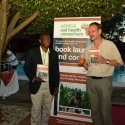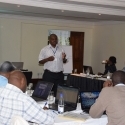25 Apr 2013
Closing Crop Yield Gaps in Africa by Use of Integrated Soil Fertility Management
In sub-Saharan Africa (SSA), the yields of the main cereal crops have stagnated at less than 25% of potentially attainable yields while the per capita food production has continued to decrease over the last 5 decades. In many parts of SSA cereal crop yields are estimated 1.5 ton ha-1 while the actual potential is more than 5 tons/ha. The low yields are largely attributable low use of organic and mineral nutrient resources, which has also resulted in negative nutrient balances (Smaling et al., 1993; Jager et al., 2001). Low crop yield trends also hold for grain legumes whose average yields have stagnated at about 0.7 ton ha-1 against a potential of up to 3 tons ha-1. These low crop yields have led to increased food insecurity, poverty and malnutrition in most parts of SSA, which are likely to worsen as the population continues to grow. Insufficient nutrient application happens because inorganic fertilizers are often too expensive for most of the farmers, whilst organic resources are available in limited quantities. However, there is potential reducing the yield gap of most common cereal and legume crops through use of integrated soil fertility management (ISFM) technologies. ISFM has been defined as ‘A set of soil fertility management practices that necessarily include the use of fertilizer, organic inputs, and improved germplasm combined with the knowledge on how to adapt these practices to local conditions, aiming at maximizing agronomic use efficiency of the applied nutrients and improving crop productivity (Vanlauwe et al., 2010). ISFM technologies can potentially produce better results when used in the context of 4R nutrient management stewardship. 4R nutrient management stewardship requires implementation of best management practices (BMPs) that optimize the efficiency of nutrient use based on the right source, rate, time and place of application. Selection of appropriate BMPs vary by location, and those chosen for a given farm are dependent on local soil and climatic conditions, crop, management conditions and other site specific factors. In the African context, successful implementation of such technologies requires involvement of all the key stakeholders in the food production value chain (farmer, extension agents, policy makers and market actors). This is the strategy IPNI and other key partners such as government departments, NARS, AGRA, and CGIAR centres are adopting to promote ISFM within the context of 4R nutrient management stewardship as affordable and more realistic option for boosting crop yields in SSA.




